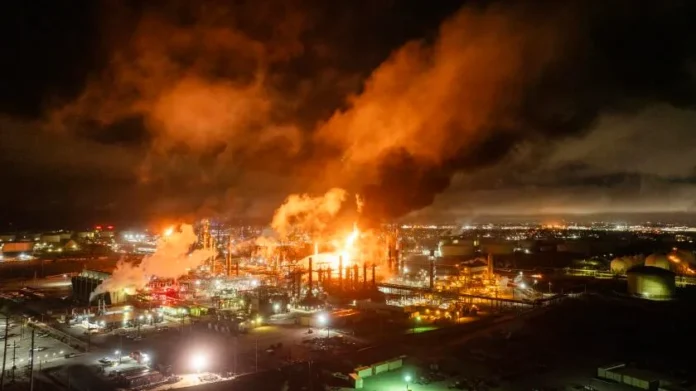
Key Developments
- Massive fireball erupted Thursday night at Chevron’s El Segundo refinery—the largest on the West Coast—sending 300-foot flames visible for miles and shaking homes across South Bay communities, though officials reported no injuries or evacuations
- Zero compensation owed presently as no property damage or personal injuries have been documented, but Chevron faces potential strict liability under California hazardous materials statutes if air quality monitoring reveals toxic exposure
- Refinery operations and market impact remain unknown as investigators continue examining the isolated fire’s cause while experts warn California gas prices could climb despite minimal global market disruption
LOS ANGELES, CA – An explosion rocked Chevron’s El Segundo refinery at approximately 9:30 p.m. Thursday, generating a fireball and sustained flames that alarmed residents across Manhattan Beach, Redondo Beach, and surrounding South Bay neighborhoods. Witnesses reported feeling a blast powerful enough to suggest a plane crash or earthquake.
Julian Reese, 13, described running outside with his father after feeling the explosion and seeing flames fill the sky. Mark Rogers, playing soccer at Aviation Park miles from the plant, thought “we got nuked or something.” Keith Mohr, a 53-year-old Manhattan Beach resident who has lived near the refinery for over two decades, called the 300-foot flames unlike anything he had witnessed and initially grabbed his dogs to evacuate.
By Friday morning, the fire had substantially diminished with little visible structural damage, though flames continued burning at the southern portion of the facility. Chevron confirmed all personnel and contractors were accounted for with no injuries reported. The company characterized it as an “isolated fire” and stated its fence-line monitoring system detected no exceedances of air quality standards.
Road closures along Rosecrans Avenue and Pacific Coast Highway diverted traffic while regional fire departments assisted Chevron’s on-site fire team. Los Angeles Mayor Karen Bass confirmed no impact to nearby LAX operations.
California imposes some of the nation’s strictest liability standards on industrial facilities handling hazardous materials. Under state law, refineries operate as inherently dangerous enterprises subject to strict liability principles—meaning Chevron could face legal responsibility for damages even without proof of negligence if harm occurs.
The primary legal question centers on causation: did the explosion cause compensable harm? Currently, the answer is no. With zero reported injuries, no property damage documentation, and no detected air quality violations, Chevron has no immediate legal obligation to compensate the community.
However, several liability scenarios could emerge:
Potential tort claims would require plaintiffs to prove actual damages—personal injury, property destruction, or economic loss—directly caused by the explosion. Emotional distress claims without accompanying physical manifestation face high evidentiary bars in California courts.
Environmental liability operates differently. If ongoing air quality monitoring reveals toxic emissions that exceeded regulatory thresholds, Chevron could face penalties under the Clean Air Act and California Health and Safety Code regardless of whether individuals suffered documented health effects. The South Coast Air Quality Management District maintains authority to levy substantial fines for violations.
Future health claims present complex causation challenges. Residents developing respiratory conditions months or years later would need to establish medical causation linking their illness specifically to Thursday’s fire—a difficult burden requiring expert testimony, exposure modeling, and elimination of alternative causes.


